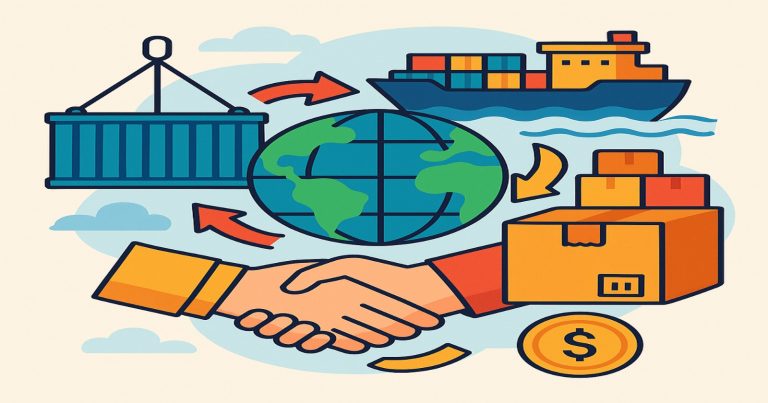External trade is the backbone of globalization and an essential mechanism for economic growth and development in the modern world. Defined as exchanging goods, services, and capital between nations, external trade allows countries to access resources and technologies they lack while sharing surplus production with global markets. External trade meaning captures the essence of international trade as a pivotal activity for fostering interdependence, cultural exchange, and economic cooperation among nations.
External Trade Meaning
External trade refers to the process of exchanging goods, services, and capital across international borders. This form of trade contrasts with domestic trade as it involves multiple countries, each with its own regulations, currencies, and trade policies. External trade is divided into three key components: export, import, and re-export, all of which facilitate the flow of goods and services worldwide.
At its core, external trade is not merely an economic activity; it is a means of connecting nations through economic partnerships. It ensures that countries can access products and services they cannot efficiently produce on their own, enabling efficient allocation of global resources. For instance, a country rich in oil but lacking in agricultural resources can trade its surplus oil to import essential food supplies.
Types of External Trade
External trade is broadly categorized into export, import, and re-export. These types highlight how nations interact economically and fulfill their trade objectives, creating a dynamic ecosystem of goods and services exchange.
Export Trade
Export trade involves selling goods and services produced domestically to buyers in other countries. It is a significant contributor to a nation’s GDP and a primary source of foreign exchange. Exporting allows countries to leverage their competitive advantages, such as unique resources, advanced technologies, or skilled labor.
Key Features of Export Trade:
- Facilitates the production of surplus goods for international markets.
- Generates foreign exchange, strengthening the national economy.
- Expand the industrial base by fostering innovation and efficiency to meet global standards.
Economic Impact of Export Trade:
Export trade enhances industrial productivity and creates employment opportunities. Countries that focus on export-oriented growth, such as China and Germany, often exhibit robust economic development due to high global demand for their products.
Import Trade
Import trade refers to the purchase of goods and services from foreign countries to fulfill domestic needs. Countries engage in imports to address resource shortages, gain access to advanced technologies, or acquire luxury goods unavailable locally.
Example of Import Trade:
Japan imports crude oil and raw materials for its manufacturing sector due to limited natural resources.
Significance of Import Trade:
- Enables countries to acquire goods that are not domestically available.
- Promotes the adoption of new technologies and innovation.
- Helps balance domestic supply and demand, stabilizing markets.
Economic Implications:
While import trade satisfies domestic demand, it may also create challenges such as trade deficits if imports exceed exports. Governments often impose tariffs and trade regulations to manage imports effectively.
Re-export Trade
Re-export trade occurs when a country imports goods and subsequently exports them to another country with minimal or no processing. Re-exporting leverages strategic trade positions, tax benefits, or geographical advantages to optimize profits.
Example of Re-export Trade:
Dubai imports raw gold, adds minimal finishing, and re-exports it as jewelry to other nations.
Re-export Trade Benefits:
- Maximizes trade opportunities using strategic geographic locations.
- Benefits from free trade zones and tax incentives.
- Enhances the role of trade hubs like Singapore and Hong Kong.
Importance of External Trade
External trade is more than an economic necessity; it is a transformative force shaping global cooperation, innovation, and cultural exchange. It enables countries to optimize resource use, improve living standards, and establish diplomatic ties through trade agreements.
Economic Growth and Development
External trade is a cornerstone of economic growth. Exporting goods creates jobs, strengthens industries, and brings foreign exchange into the economy. Similarly, importing essential products ensures that domestic markets remain vibrant and competitive.
Example of Economic Growth through Trade:
China’s rise as a global economic superpower is fueled by its extensive exports of consumer electronics, machinery, and textiles.
Impact on Developing Economies:
For developing countries, trade provides access to international markets, boosting their growth potential. Foreign trade also supports infrastructure development and technological advancements, making them globally competitive.
Access to Global Markets
External trade opens new avenues for businesses to expand beyond domestic boundaries. Global market access allows companies to diversify their consumer base, mitigating risks associated with relying solely on local markets.
Advantages:
- Encourages economies of scale through large-scale production.
- Builds brand recognition in international markets.
- Provides exposure to diverse customer preferences, fostering innovation.
Case Study:
South Korean conglomerates like Samsung and LG have gained international prominence through global trade, showcasing how access to external markets propels businesses onto the global stage.
Resource Optimization
Trade allows countries to specialize in producing goods they can create most efficiently, a principle known as comparative advantage. Nations can focus on industries where they excel while importing goods they produce less efficiently.
Example:
Brazil specializes in agricultural exports like coffee and soybeans while importing machinery and technology.
Benefits of Resource Optimization:
- Reduces wastage of resources.
- Enhances global productivity.
- Balances supply and demand across regions.
Innovation and Technology Transfer
External trade facilitates the exchange of ideas, knowledge, and technology between nations. By importing advanced machinery or partnering with foreign companies, domestic industries can upgrade their processes and enhance productivity.
Example of Technology Transfer:
India’s adoption of green energy technologies from Europe has accelerated its renewable energy sector.
Impact on Innovation:
Trade encourages businesses to innovate continuously, ensuring they remain competitive in global markets. This innovation leads to the development of new products, improved services, and cost-efficient processes.
Strengthening Bilateral Relations
Trade agreements and partnerships pave the way for stronger diplomatic ties. Countries that engage in robust trade often establish long-term cooperative relationships, which can extend to political and cultural exchanges.
Examples of Bilateral Trade Agreements:
- The North American Free Trade Agreement (NAFTA) enhanced trade among the US, Canada, and Mexico.
- The India-UAE trade corridor fosters economic and cultural exchange between the two nations.
External Trade FAQs
What is the external trade meaning?
External trade refers to the exchange of goods, services, and capital between nations, including exports, imports, and re-exports.
Why is external trade important for a nation?
External trade fosters economic growth, promotes technology transfer, optimizes resource use, and builds international cooperation.
What are the types of external trade?
The three main types are export trade (selling domestic goods abroad), import trade (purchasing foreign goods), and re-export trade (exporting imported goods).
How does external trade benefit businesses?
It provides access to global markets, encourages innovation, and enables economies of scale, increasing profitability.
What are the challenges of external trade?
Challenges include currency fluctuations, trade barriers, political instability, and compliance with international trade regulations.


